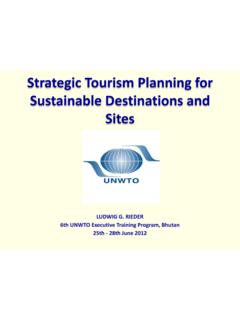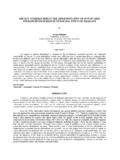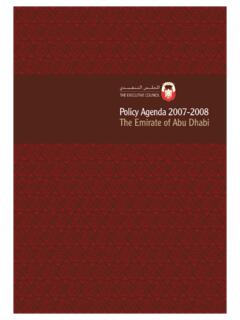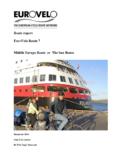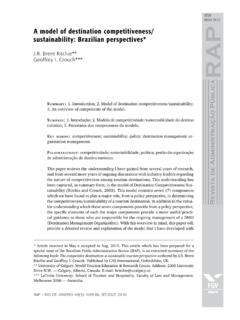Transcription of Agritourism: Potential Socio-Economic Impacts In Kisumu …
1 IOSR Journal Of Humanities And Social Science (IOSR-JHSS). Volume 20, Issue 3, Ver. VII (Mar. 2015), PP 78-88. e-ISSN: 2279-0837, p-ISSN: 2279-0845. Agritourism: Potential Socio-Economic Impacts In Kisumu County , , ,, Stephen G. Agong4, and 1. PhD student and researcher, Jaramogi Oginga Odinga University of Science and Technology;. 2. Supervisor and deputy vice Chancellor, 3. Supervisor and s/lecturer, School of Agricultural and Food Sciences, 4. Vice Chancellor (Professor), Jaramogi Oginga Odinga University of Science and Technology 5. Dean, School of Spatial Planning and Natural Resources Management Abstract: High poverty level is one of the major developmental challenges facingKisumu County with over 60. percent of the population being poor. The main economic activity in this region has for a long time been farming. The high incidences of poverty level is attributed to several factors ranging from the ever escalating costs of farm inputs, poor distribution and unpredictable rains, poor farming methods resulting to poor crop/livestock production hence low yields and food insecurity, lack of diversified agriculture, environmental degradation, lack of empowerment, HIV/AIDS scourge and low incomes.
2 This calls for farmers to find alternative sources of livelihoods to generate additional income. From an exploratory survey conducted in Kisumu County in July 2014 on Agritourism as a strategy for poverty alleviation and livelihood improvement, percent of the respondents indicated Agritourism as a viable venture for farmers in this county. This paper builds on this survey to reveal the Potential Socio-Economic Impacts of practicing Agritourism in Kisumu County. Factors to be analysed includedpoverty levels, education levels, land tenure systems, employment status and family incomes. Both qualitative and quantitative data were collected. Quantitative data collection entailed a household survey through administration of questionnaires while qualitative method involved interviews and focus group discussions. Participants consisted of farmers and key informants in relevant county government offices in the study area.
3 The paper reveals that the Potential Socio-Economic Impacts for Agritourism in Kisumu County are great and largely untapped. Potentialsrevealed included the possibility of generating opportunities for local farmers to increase income, revenue generation and improved food security, enhanced entrepreneurial skills and the diversification and uniqueness of traditional food crops within the county. Agritourism may reduce rural-urban migration of the young populace since it will provide incentives to preserve agricultural land in Kisumu County and create employment opportunities. More opportunities for value addition of farm produce will be created and diversification of produce for direct-marketing may stimulate economic activity. With improved infrastructural support, Agritourism programs may help capitalize on the natural, historical, and cultural resources of communities and also build community pride and improve the quality of life for local community.
4 The study concluded that concerted effort of all stakeholders is needed to exploit the Socio-Economic benefits of Agritourism. To sustain Agritourism, there is need for stakeholder sensitization and strategic planning for Agritourism in Kisumu . The County government should explore public- private partnerships that are beneficial to further the pursuit and development of Agritourism in Kisumu County. Key Words: Agritourism, livelihood, tourism, economic growth, poverty reduction. I. Introduction The constant instability of net farm incomes and the loss of jobs in rural areas have led to a human and financial capital drain from many rural areas, with many farming families and businesses under economic stress (Stewart, 2002). Rural-urban migration, infrastructure development, national policies, private sector forces, and other aggressive Socio-Economic and political processes, including globalisation, drive urbanisation across the developing world (United Nations 2007:7).
5 Lack of employment opportunities in the rural areas is the main push factor driving this process while the main pull factor is the anticipated job availability. Isaac and Van der Sterren (2004:2) argue that tourism and its products are a possible strategy of growth for developing economies and an agent of development because of its Potential to be a source of income for local economies. One of the driving forces that is becoming of great interest in the agricultural sectors to diversify their income sources is to embrace agritourism practices into their daily farming activities (Viljoen and Tlabela, 2006:15). Agritourism is emerging as an alternative form of tourism. Introduction of Agritourism can be a catalyst to both income and non-income benefits to farmers. Globally, Agritourism is gaining fame and is now considered a Potential source of income. As countries that primarily focus on tourism or agriculture look for ways to enhance their activities, DOI: 78 | Page Agritourism: Potential Socio-Economic Impacts In Kisumu County Agritourism has become a primary focus.
6 Kisumu Local Interaction Platform formed a consortium which recognizes that Agritourism as part of ecotourism can be an alternative livelihood with a focus on climate change, environment and poverty within urban agriculture and food security context within Kisumu City and its environs (KLIP, 2013). From existing literature on Agritourism, there is no universal definition of the concept. According to Schilling et al. (2006), it is also known as Agrotourism . It is the process of attracting visitors and travelers to agricultural areas, generally for educational and recreational purposes (Lamb, 2008; Veeck et al. 2006). Viljoen and Tlabela (2006) describe it as part of rural tourism which consists of leisure activities carried out in rural areas including community based tourism and cultural tourism. This paper, adapted Hsu s (2005:20) definition that Agritourism also known as farm tourism or agricultural tourism is an interaction between the agricultural producer, his/her products and services, and the tourists.
7 The products combine agriculture- its natural setting and products with a tourism experience. Tourists are provided with opportunities to experience a broad spectrum of products and services, including farm-based bed and breakfast, farm tours to see agricultural products, culture, arts and crafts, and natural heritage thereby benefitting the local people socio-economically. Agritourism can contribute to the overall income, cash flow and profitability of a farm by providing alternative income via farm products, and farming activities (Colton and Bissix, 2005; Huybers, 2007; Keith et al. 2003;. Sharply, 2002). Agritourism activities should aim to improve the quality of life by creating jobs, have an impact on the social and economic aspects, as well as the multifunctional development of rural sustainable development (Wyporska and Mosiej, 2010). According to Kurek (2007) the needs of local communities should be given serious attention in tourism development which will in turn result in improvement of standards of living, high tourist expectations and the protection of natural and cultural environments.
8 Governments and all stakeholders including the local communities and the relevant institutions in a country need to work together so that the utilization, development and management of tourist areas should be given serious attention (Nandi, 2008;. Narayan, 2000). Economic dimensions of tourism do not only depend on the input, but also on other sectors such as the agricultural sector which complements tourism through Agritourism (Cikin, Ceken, and Ucar, 2009). II. Literature Review Agritourism practice in the world. Literature has it that Agritourism started in the United States in the early 1800s (Karabati et al., 2009). A number of countries of the world have transformed their economies through agro-tourism activities. The Inter-American Institute for Cooperation on Agriculture (IICA) has been promoting Agritourism in the Caribbean since 2005 to strengthen links between tourism and agriculture (IICA, 2011).
9 In Thailand, it has been used as one of the main medium to attract tourists from all over the world. Since the advent of Agritourism in Thailand in 2002, Agritourism has created a great impact by having a record of more than half a million tourists visiting farm areas in a national scheme (Taemsaran, 2005). In Europe, Agritourism has become a way of life for Europeans as a large percentage of Europeans take farm holidays (Frater, 1983). In Greece for instance, the Ministry of Agriculture embraced Agritourism and this is reported to have promoted the mountainous and less favoured areas to attract tourists (Aikaterini et al., 2001). Agritourism industry is gaining ground in Malaysia as the country has a wealth of products for visiting tourists (Hamzah, 2011). Main activities involved in the area entail farm visits and home stays. It is reported that Agritourism activities are diversified and entail consumption of natural resources and the local culture as well as the development of personal relationships between visitors and the local community (Iakovidou, 1997 in Lathiras et.)
10 Al., 2010) and these activities increase the economic income of the local community (Sosnowski and Ciepiela, 2011).The country has more than hundred tourist destinations that offer Agritourism activities. Hamilpurka (2012) indicated that Agritourism in Karnataka, India, has improved farmers income and also contributed to educating the tourists and local communities on sustainable agriculture. In Africa, Agritourism has a short history and in most countries it is at the developing stages (Maumbe, 2012; Bernardo et al., 2007).Agritourism is improving South Africa s economic performance as well as contributing to rural development and employment creation (Kepe et al., 2001). It is utilized as a means to alleviate poverty and create employment opportunities in rural areas. In Ghana, Fanteakwa District in 2007. attracted over 4,000 paying visitors who were interested in cocoa farms Cocoa (2006:7).










